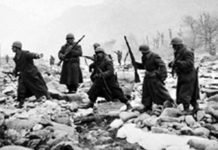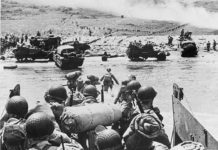The misinterpreted Russian Navy mission in the US Civil War may have accidentally helped the North win the conflict.
In 1863, it looked as if the mighty British Empire may intervene in the US Civil War on the side of the Confederate States (CSA). War fever had come to London early in the conflict after the “Trent Affair” placed the Her Majesty’s Navy and Army on alert. British firms such as Enfield and Whitworth sold tremendous amounts of arms of all kinds to Confederate agents and these were in turn often smuggled through the US Naval quarantine via British blockade-runners. Confederate raiders including the notorious CSS Alabama and CSS Shenandoah were constructed in English harbors. British war tourist Colonel (later General Sir) Arthur Fremantle in 1863 had just returned from three months among both the US and Confederate commands fighting the war and loudly pronounced that the Confederates would certainly be victorious.
Relations with the Tsar and the Union
Relations between the United States and Tsarist Russia were warmer than with many other European nations at the time. Cassius Marcellus Clay, a well-known abolitionist, was the US Ambassador to the court of Tsar Alexander II during the conflict. It was Clay’s report on the Tsar’s Emancipation of 23,000,000 Russian Serfs in 1861 helped pave the way for Lincolns own Emancipation Proclamation of the 4,000,000 American Negro slaves the next year. American engineers and railway organizers were helpful in starting the early Russian railway system. Clay openly encouraged a military alliance with between the US and Britain, France, and possibly Spain openly thought of Russia as a hedge between what as a possible intervention on the Confederate side.
The Russians Arrive
Suddenly, on September 24, 1863, two separate Russian naval squadrons arrived in US waters unannounced on both the East and West coasts. The Russian Atlantic fleet on the US East Coast had sailed from the Baltic and arrived at New York under command of Rear Admiral Lesovskii with three large frigates and three smaller vessels. The fleet included the new and fearsome 5,100-ton US-built screw frigate Alexander Nevsky with 51 sixty-pounder naval guns. The Russian Pacific fleet that arrived on the West Coast in San Francisco was under command of Rear Admiral Popov and consisted of four small gunboats and a pair of armed merchants cruisers. The ships were saluted, and allowed entry as being on a friendly port call.
The American media and political machine immediately interpreted the reason for these naval visits as clear Russian support for the US cause. The real reason however seems to be something quite different. Poland, largely occupied by Russia, was in open revolt in the summer of 1863. The so-called Polish Crisis followed in which there was a possibility that Britain and or France would intervene on the side of the insurgent Poles. The Tsar, fearing that his isolated Pacific and Atlantic naval squadrons would be seized or destroyed by superior British or French units in the event of war, sent them into the neutral US ports to seek refuge. This fact was held from the Americans and the fleet’s Russian officers simply stated that they were in US ports for ‘not unfriendly purposes”
The respective admirals of the Russian squadrons had sealed orders to place themselves at the disposal of the US government in the event of a joint British or French intervention on both Russia and the United States. In the event of Russia entering into war with the Anglo-French forces alone then the Russian ships were to sortie against the commercial fleets of those vessels as best as they could and then seek internment.
The Outcome of the Visit
Several historians claim that the British government saw this mysterious visit by the Russians in US waters as an open confirmation of a secret military pact between the two future super powers. This interpretation further helped deter foreign recognition of the Confederate cause and resulted in the extinguishing of the South’s flame of hope. It can also be claimed that it stalled British intervention in the Tsar’s problems in Poland with the thought that it could result in a US invasion of Canada.
When the Polish Uprising crisis abated in April 1864, the Russian fleets were recalled quietly to their respective home waters. The dozen Tsarist warships had conducted port calls and training cruises in US and neighboring waters for almost seven months during the war while managing to avoid the conflict altogether. In the late fall of 1863 with rumors of Confederate raiders lurking on the West Coast, Admiral Popov confirmed to the governor of California that he and his fleet would indeed protect the coast of their defacto ally if the raiders did actually appear. The effect of this ‘fleet-in-being’ resulted directly in an increase in US-Russian relations.
The US Navy, on the cutting edge of ironclad steam warship design, passed along plans and expertise to their Russian colleagues who had no such vessels. By 1865, the Tsar had a fleet of ten ultra modern 200-foot long ironclad battleships based on the monitor USS Passaic. These ships, known to the Russians as the Uragan (Bronenosetz) class were completed even with two US-designed 15 inch smoothbore Dahlgren guns and far outgunned any other European navy of the time.
In 1867, Russian Ambassador Baron Stoeckel advised US Secretary Seward that the Russian government would entertain bids for the failing colony of Alaska, which was rapidly accepted. Cassius Clay, still in Russia helped to conduct the negations from inside the Winter Palace. The Russians even rapidly transferred control of the territory, which was seen by many to be worthless nearly a year before Congress ratified the transfer and in effect, couldn’t give it back.
This odd incident of the Russian fleets’ visit may have prevented what would have certainly been one of the planet’s first and possibly oddest of world wars. The real reasons for the Russian fleet’s visit were only uncovered and publicized nearly fifty years later in 1915 by military historian Frank Golder.
By that time the Uragan class monitors were long scrapped, Alaska was a US territory and Russia was finally at war with Britain and France- this time as allies against Germany and Austria in World War One.
Sources:
- Bourne, Kenneth. British Preparations for War with the North, 1861-1862. The English Historical Review Vol 76 No 301 (Oct 1961) pp 600–632
- Brune, Lester H and Burns, Richard Chronological History of U.S. Foreign Relations: 1607-1932
- Delahaye. Tom The Bilateral Effect of the Visit of the Russian Fleet in 1863 Loyala University Historical Journal 1983








